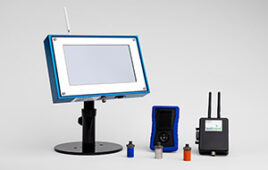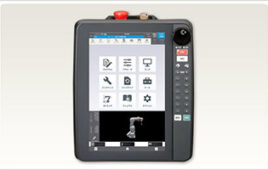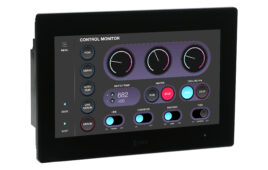
Within aerospace manufacturing, various heavy-duty, metal forming, hydraulic presses are required to bend, form, bond, or straighten aluminum, Titanium, and alloys into structures and components such as fuselages, spars, and airframes.
Although the aerospace forging industry has been in existence for many decades, today’s forge press HMIs are enhancing production uptime and control. A Human-Machine Interface (HMI) is a user interface or dashboard that connects a person to a machine or forging system. HMI are software applications that graphically present information to operators about the state of various processes in a format that looks like the actual machine or display panel.
In the aerospace forging industry, design engineers are creating HMIs that enable users to see how equipment is functioning and anticipate how it should be performing. This is accomplished with dynamic animated models and schematics, live trending, and diagrams.
“Cutting edge HMIs are visual learning tools for forging operators to observe the normal machine operation, to expedite troubleshooting when something goes wrong,” said Bill Goodwin, Vice President of Sales and Engineering, Erie Press Systems.
“Even less experienced personnel can look at a well-designed HMI screen, watch the press run, and then learn how it functions. Operators can monitor live press positional and force data as the machine transitions through the production cycle. When something is out of sequence or stops abruptly mid-cycle, they can quickly troubleshoot because the HMI provides a graphical window into the machine control system and its processes, identifying problem areas,” added Goodwin.
Traditional Limitations
With massive forging presses wielding tons of force to shape workpieces, maintaining production uptime and minimizing unexpected repairs and maintenance is critical.
However, aerospace manufacturers with forging equipment have long had to rely on experienced operators using manual gauges to take a momentary snapshot of individual components’ condition. While useful, this was not comprehensive, and if not caught in routine maintenance, typically left developing problems undiagnosed until costly production line breakdowns resulted.
“With manual gauges, if a pump started to fail, the operator might not notice until the machine was unable to complete a cycle,” said Goodwin.
Often, newer operators did not have the experience to recognize if forging equipment was operating as it should. Complicating matters, if problems occurred, they frequently wasted valuable time trying to track down experienced operators or technical documentation.
“At times, a forging machine would stop, and no one knew what was wrong with it, why it stopped, or where [in the production cycle] the error occurred,” said Goodwin.

Isothermal (hot die) forging from Ajax-CECO-Erie Press can help eliminate some problems associated with manufacturing related to more complex parts.
HMIs in Forging
Aerospace forging presses with the most advanced HMI capabilities help operators see and monitor what is happening with enough insight to successfully troubleshoot and promptly get the equipment back online when required. Although HMIs are becoming popular in the industry, there are distinct differences in capability between basic and advanced options.
The most rudimentary HMIs are visual terminals where information can be entered and data viewed, but no new information is stored.
In contrast, advanced HMIs enable saving/retrieving data, custom searches, and the display of historical trends. Far from rudimentary, up-to-date PDF technical documents and the schematics of each component on the machine are searchable and can be quickly displayed as needed. However, the most distinguishing capability of HMIs is how the software applications ease operator understanding and control of the forge press, along with any necessary troubleshooting.
Advanced HMIs provide dynamically animated schematics that allow the operator to watch the forging equipment while it’s running. Operators can quickly “drill down” from a top-level animated schematic to review the performance of specific components, such as valves and pumps, and locate information on part numbers and wiring schemes.
Goodwin said that Erie Press engineers start with a digital SolidWorks model of the press, import it into HMI software, and then “break it apart” and dynamically animate it while displaying vital operational statistics.
With an animated hydraulic schematic, for example, the hydraulic pressure source from multiple pumps is displayed in one location for instant verification. The operator can monitor the current press state shown in a text box, and fields indicating the pressure in the main and pullback cylinders. The valve command and actual spool feedback are displayed for each proportional valve.
According to Goodwin, the press operator can also monitor main ram tonnage, main cylinder pressure, moving platen position, last cycle time, and current cycle time.
Using this information, forge personnel can more effectively learn the press’s internal operation by observing all this data as it cycles through operation to enable quick diagnosis and action if there is a potential issue.
For example, Ajax-CECO-Erie Press has developed an online diagnostic system for remote monitoring and support through a remote Ethernet diagnostic connection provided on all new equipment. The Ethernet-based control system provides OEM engineers with a platform to remotely view the machine’s health as it is operating.
“The goal is to avoid production downtime by preventing problems as well as reducing the time to find, diagnose, and solve them,” said Goodwin. “Remote diagnostics allow us to monitor the forging equipment to resolve any potential issues promptly.”
According to Goodwin, such capability — along with implementing some redundant components like electronic position transducers ¬— can keep production online even if a part fails. “If one fails, we can dynamically switch to the good one. Traditionally, one failed transducer leads to downtime until a technician can acquire the correct part and change it out on-site,” he said.
He noted that such a system also enables the viewing of historical trends and up-to-date, searchable PDF technical documents and schematics, and dynamic animated schematics.
“With historical data, if a component is starting to fail, maintenance can often identify and replace it before catastrophic failure,” said Goodwin.
He pointed out that next-level HMIs enable a historical review of how forging equipment functioned at specific dates and times. When the operator simply “pins” certain types of data or moves a graphic slider representing a slice in time that serves as an icon on a smartphone, the HMI displays the data on how the forging equipment was performed at the exact day and time.

A hot stretch straightener machine like this from Ajax-CECO-Erie Press, is used to resistively heat, stretch, and straighten long extruded tubes or flat plates because the cooling process after the heated extrusion cycle tends to introduce curvature.
In the case of Ajax-CECO-Erie Press, forge equipment with an HMI includes a library of datasheets for its electrical, mechanical, and hydraulic devices. Electrical schematics, hydraulic schematics, and mechanical assembly drawings can be viewed and printed from an HMI. The data sheets are in PDF format, which enables keyword searching within the document.
“Instead of spending days trying to locate the right technical documentation and reading through data sheets or wiring schematics that can be 100 pages long, the data is searchable and immediately available to operators,” said Goodwin.
In fact, next-level HMIs take search capability much farther by enabling the “drilling down” from a high-level, dynamic, graphic animation of the equipment to quickly “zero in” on the specific data, schematic, or drawing required.
While aerospace forging presses are traditionally viewed as decades-old technology, advanced HMIs are becoming virtually as simple to monitor and use as an operator’s favorite smartphone while making critical performance data readily available as well.
The bottom line for manufacturers relying on the efficient use of forging equipment is that new capabilities can significantly increase production uptime and profitability, providing a critical edge over competitors.
Ajax-CECO-Erie Press
www.AjaxErie.com
Filed Under: Displays • HMIs • operator interfaces • monitors




